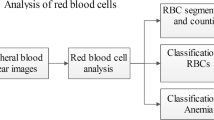Abstract
Inherited hemoglobin disorders include thalassemias and structural variants like HbS, HbE, and HbD, Hb Lepore, HbD-Iran, Hb-H disease and HbQ India. HbQ India is an uncommon alpha-chain structural hemoglobin variant seen in North and West India. Patients are mostly asymptomatic and often present in the heterozygous state or co-inherited with beta-thalassaemia. This study was done in a tertiary care teaching hospital in North India over a period of 7 years among patients referred from antenatal and other clinics for screening of hemoglobin disorders. Complete blood count, peripheral blood smear examination and cation exchange high performance liquid chromatography (HPLC) was done to quantify various hemoglobins. HbQ India was diagnosed if the unknown variant hemoglobin was detected within the characteristic retention window. Of a total of 7530 patients screened, 31 (0.4%) were detected to have HbQ India. Of these, 25 (0.3%) patients had HbQ India trait and 6 (0.1%) patients had compound heterozygosity for HbQ India and Beta Thalassemia trait (HbQ India-BTT). All patients were clinically asymptomatic and were detected as part of the screening for hemoglobin disorders. Only two patients with HbQ India-BTT had hemoglobin less than 10 g/dL. In 25 patients with HbQ India trait, HbQ ranged from 13.6 to 24.4% and in 6 patients with HbQ India-BTT, HbQ India ranged from 7.4 to 9.0%. HbQ India is an uncommon structural hemoglobin variant. Although asymptomatic, it may cause diagnostic difficulty in the compound heterozygous state with beta thalassemia. HPLC provides a rapid, accurate and reproducible method for screening of this condition to identify and counsel individuals.

Similar content being viewed by others
References
Rao S, Kar R, Gupta SK, Chopra A, Saxena R (2010) Spectrum of haemoglobinopathies diagnosed by cation exchange-HPLC and modulating effects of nutritional deficiency anaemias from North India. Indian J Med Res 132:513–519
Phanasgaonkar S, Colah R, Ghosh K, Mohanty D, Gupte S (2007) Hb Q(India) and its interaction with beta-thalassaemia: a study of 64 cases from India. Br J Biomed Sci 64:160–163
Sachdev R, Dam AR, Tyagi G (2010) Detection of Hb varaints and hemoglobinopathies in India population using HPLC: report of 2600 cases. Indian J Pathol Microbiol 53:57–62
Panigrahi I, Bajaj J, Chatterjee T, Saxena R, Mahapatra M, Pati HP (2005) Hb Q India: Is it always benign? Am J Hematol 78:245–246
Vella F, Wells RH, Ager JA, Lehmann H (1958) A haemoglobinopathy involving haemoglobin H and a new (Q) haemoglobin. Br Med J 1:752–755
Sukumaran PK, Merchant SM, Desai MP, Wiltshire BG, Lehmann H (1972) Haemoglobin Q India (alpha 64(E13) aspartic acid histidine) associated with beta-thalassemia observed in three Sindhi families. J Med Genet 9:436–442
Mutreja D, Tyagi S, Tejwani N, Dass J (2013) Double heterozygous hemoglobin Q India/hemoglobin D Punjab hemoglobinopathy: report of two rare cases. Indian J Hum Genet 19:479–482
Kaler AK, Veeranna V, Bai U, Raja P, Kaur P (2013) Role of HPLC in the diagnosis of hemoglobin Q disease. IJHSR 3:96–99
Abraham R, Thomas M, Britt R, Fisher C, Old J (2003) Hb Q-India: an uncommon variant diagnosed in three Punjabi patients with diabetes is identified by a novel DNA analysis test. J Clin Pathol 56:296–299
Pérez SM, Noguera NI, Acosta IL, Calvo KL, Bragós IM, Rescia V et al (2010) Compound heterozygosity of Hb Q India (α64 (E13) ASP → HIS) and −α3,7 thalassemia. First report from Argentina. Revista Cubana de Hematologia, Inmunologia y Hemoterapia 22:236–240
Bhat VS, Dewan KK, Krishnaswamy PR, Mandal AK, Balaram P (2010) Characterization of a hemoglobin variant: HbQ-India/IVS 1–1 [G > T]-β-thalassemia. Indian J Clin Biochem 25:99–104
Leung KF, Ma Es, Chan AY, Chan LC (1981) Clinical phenotype of hemogobin Q-H disease. J Clin Pathol 57:81–82
Sharma S, Sharma P, Das R, Chhabra S, Hira JK (2017) HbQ-India (HBA1:c.193G> C): hematological profiles and unique CE-HPLC findings of potential diagnostic utility in 65 cases. Ann Hematol 96:1227–1229
Acknowledgements
We acknowledge the support given by the Indian Council of Medical Research (ICMR), New Delhi as most of the patients had been worked up during an ICMR funded screening project.
Author information
Authors and Affiliations
Corresponding author
Ethics declarations
Conflict of interest
The authors declare that they have no conflict of interest.
Ethical Approval
All procedures performed in studies involving human participants were in accordance with the ethical standards of the institutional and/or national research committee and with the 1964 Helsinki declaration and its later amendments or comparable ethical standards. No patient/subject identifying information has been disclosed in the manuscript. No patient/subject intervention was done and the subjects were not exposed to any risks during the study.
Informed Consent
Since the study involved a retrospective review of data only from routine testing offered by the laboratory, separate informed consent was not taken for the study. “For this type of study formal consent is not required.”
Rights and permissions
About this article
Cite this article
Harrison, A., Mashon, R.S., Kakkar, N. et al. Clinico-Hematological Profile of Hb Q India: An Uncommon Hemoglobin Variant. Indian J Hematol Blood Transfus 34, 299–303 (2018). https://doi.org/10.1007/s12288-017-0864-2
Received:
Accepted:
Published:
Issue Date:
DOI: https://doi.org/10.1007/s12288-017-0864-2




